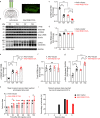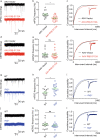PKA-RIIβ autophosphorylation modulates PKA activity and seizure phenotypes in mice
- PMID: 33649504
- PMCID: PMC7921646
- DOI: 10.1038/s42003-021-01748-4
PKA-RIIβ autophosphorylation modulates PKA activity and seizure phenotypes in mice
Abstract
Temporal lobe epilepsy (TLE) is one of the most common and intractable neurological disorders in adults. Dysfunctional PKA signaling is causally linked to the TLE. However, the mechanism underlying PKA involves in epileptogenesis is still poorly understood. In the present study, we found the autophosphorylation level at serine 114 site (serine 112 site in mice) of PKA-RIIβ subunit was robustly decreased in the epileptic foci obtained from both surgical specimens of TLE patients and seizure model mice. The p-RIIβ level was negatively correlated with the activities of PKA. Notably, by using a P-site mutant that cannot be autophosphorylated and thus results in the released catalytic subunit to exert persistent phosphorylation, an increase in PKA activities through transduction with AAV-RIIβ-S112A in hippocampal DG granule cells decreased mIPSC frequency but not mEPSC, enhanced neuronal intrinsic excitability and seizure susceptibility. In contrast, a reduction of PKA activities by RIIβ knockout led to an increased mIPSC frequency, a reduction in neuronal excitability, and mice less prone to experimental seizure onset. Collectively, our data demonstrated that the autophosphorylation of RIIβ subunit plays a critical role in controlling neuronal and network excitabilities by regulating the activities of PKA, providing a potential therapeutic target for TLE.
Conflict of interest statement
The authors declare no competing interests.
Figures







Similar articles
-
Single Turnover Autophosphorylation Cycle of the PKA RIIβ Holoenzyme.PLoS Biol. 2015 Jul 9;13(7):e1002192. doi: 10.1371/journal.pbio.1002192. eCollection 2015 Jul. PLoS Biol. 2015. PMID: 26158466 Free PMC article.
-
Deficiency of the RIIβ subunit of PKA affects locomotor activity and energy homeostasis in distinct neuronal populations.Proc Natl Acad Sci U S A. 2013 Apr 23;110(17):E1631-40. doi: 10.1073/pnas.1219542110. Epub 2013 Apr 8. Proc Natl Acad Sci U S A. 2013. PMID: 23569242 Free PMC article.
-
Hypothalamic PKA regulates leptin sensitivity and adiposity.Nat Commun. 2015 Sep 18;6:8237. doi: 10.1038/ncomms9237. Nat Commun. 2015. PMID: 26381935 Free PMC article.
-
Molecular neuropathology of temporal lobe epilepsy: complementary approaches in animal models and human disease tissue.Epilepsia. 2007;48 Suppl 2:4-12. doi: 10.1111/j.1528-1167.2007.01062.x. Epilepsia. 2007. PMID: 17571348 Review.
-
Gene expression profile in temporal lobe epilepsy.Neuroscientist. 2007 Apr;13(2):100-8. doi: 10.1177/1073858406295832. Neuroscientist. 2007. PMID: 17404370 Review.
Cited by
-
ADCY3: the pivotal gene in classical ketogenic diet for the treatment of epilepsy.Front Cell Neurosci. 2024 May 22;18:1305867. doi: 10.3389/fncel.2024.1305867. eCollection 2024. Front Cell Neurosci. 2024. PMID: 38841200 Free PMC article.
-
Autism-associated SCN2A deficiency disrupts cortico-striatal circuitry in human brain assembloids.bioRxiv [Preprint]. 2025 Jun 3:2025.06.02.657036. doi: 10.1101/2025.06.02.657036. bioRxiv. 2025. PMID: 40501703 Free PMC article. Preprint.
-
RIIβ-PKA in GABAergic Neurons of Dorsal Median Hypothalamus Governs White Adipose Browning.Adv Sci (Weinh). 2023 Feb;10(5):e2205173. doi: 10.1002/advs.202205173. Epub 2022 Dec 18. Adv Sci (Weinh). 2023. PMID: 36529950 Free PMC article.
-
Microglial over-pruning of synapses during development in autism-associated SCN2A-deficient mice and human cerebral organoids.Mol Psychiatry. 2024 Aug;29(8):2424-2437. doi: 10.1038/s41380-024-02518-4. Epub 2024 Mar 18. Mol Psychiatry. 2024. PMID: 38499656
-
Redox Regulation of cAMP-Dependent Protein Kinase and Its Role in Health and Disease.Life (Basel). 2025 Apr 16;15(4):655. doi: 10.3390/life15040655. Life (Basel). 2025. PMID: 40283209 Free PMC article. Review.
References
Publication types
MeSH terms
Substances
LinkOut - more resources
Full Text Sources
Other Literature Sources
Molecular Biology Databases

